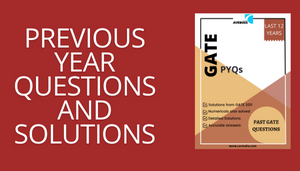GATE Architecture
Books: Printed and Online.
Videos with theory and past questions.
Topic Based Tests and Mocks.
Discount coupons for IIT, NIT grads, SPA Grads and 7.5+ CGPA students.
GATE Architecture Courses

GATE Architecture Printed Study Material
2000+ pages multi-coloured books as per new syllabus.
Covers Common Section, Architecture, Planning and General Aptitude.
Discounted fees for IIT-NIT-SPA grads and 7.5+CGPA. See Details.
Rs. 7499

GATE Architecture Online Study Material
Best GATE Architecture Online Study Material.
Accessible via app and on desktop.
Buy for a week, month or a year.
Discount coupons available for IIT-NIT-SPA grads and 7.5+CGPA. See Details.
Check Options

GATE Architecture Online Test Series
No. 1 Test Series for GATE Architecture.
170 Architecture Topic Based Tests, 50 Aptitude Tests. PYQs. 5 All India Mocks.
Buy for a week, month or a year.
Discount coupons available. See Details.
Check Options

GATE Architecture Video Lectures
500+ hours of video lecture recordings of our live classes.
Almost like self-paced live classes!!
Covers Architecture Theory and Numerical Questions separately.
Buy for a week, month or year.
Discount coupons for IIT-NIT-SPA grads and 7.5+ CGPA. See Details.
Check Options

GATE Architecture Past Paper Solutions (PYQs)
Printed book comprising GATE Architecture Past Year Papers with Detailed solutions. Available Year-wise or Chapter-wise format. From GATE 2007 to GATE 2023. Also available on Amazon.
Rs. 749

GATE Architecture Live Classes
Classes on weekends by IIT-SPA grads. All faculty below GATE AIR 20 ranks.
Covers all Numerical Topics from Common Section, Arch & Planning, Aptitude.
Recorded backup in case you miss a class.
Rs. 15000
Our Faculty
Sample Books
All courses can be viewed both on phone and on PC/desktop. To see on PC, use the URL: https://courses.cavindia.com/learn/account/signin
As a registered Career Avenues GATE Architecture student, you can ask your doubts here and our faculty will get back to you. https://bit.ly/cav-doubts
You can enrol through this website or through our app using upi, wallet payments, net-banking, debit and credit cards of most banks. If you still have a difficulty, please call or whatsapp on 9930406349 and we will assist you. After enrolment, please fill enrollment form here: http://bit.ly/cav-enrol-form
Each of us requires a different kind of study program based upon our style/preference of studying. Normally, all students take our study material and test series. Many also take video lectures as it helps them clear concepts. A lot depends upon time available to prepare, current stage of preparation, etc. If you are still unsure, please contact us.
Typically 5-6 months are required, but some students need a longer time frame based on other commitments. College students start preparation 12-18 months before GATE to have more time to practise questions as they may have semester exams as well.
We suggest about 800 to 1200 hours of preparation time overall. This can be divided into 3-4 months or 12-18 months, based on your schedule.
Tips for GATE Architecture (AR) Preparation:
If starting 3-4 months prior to the exam:
- Start with GATE Architecture (AR) section tests and mocks.
- Focus on topics you struggle with and read up on those specifically.
If starting 6-8 months prior to the exam:
- Plan a schedule with 2-3 weeks per subject.
- Study theory material and solve questions for each subject.
- Take online section tests after completing two subjects.
- Revise all subjects weekly and take regular mocks.
If starting 10-18 months prior to the exam:
- Start with 2-3 subjects that you are strong in and have studied in college.
- Study theory material and solve questions for each subject.
- After completing these subjects, move on to subjects that require more effort and time..
- Solve online section tests and mocks, referring to theory for difficult topics.
If you had no prior serious preparation:
- Start from scratch and choose a study plan based on available time.
If you had serious preparation in the past:
- Identify strengths and weaknesses and work on both.
- Seek personalized guidance from faculty to make a customized plan.
- Many students use Career Avenues Numerical Classes or Video Lectures, etc.
For more assistance, contact gate@careeravenues.co.in
The syllabus for GATE Architecture consists of both common sections and optional sections, as follows:
Common Section (Part A):
This section is common to both Architecture and Planning students. It comprises 39 questions carrying a total of 60 marks. The topics covered include:
- Architecture, planning, and design
- Construction and management
- Environmental planning and design
- Urban design, landscape, and conservation
- Planning process
- Housing
- Services and infrastructure
Optional Sections:
After the common section, there are two optional sections: Part B1 (Architecture) and Part B2 (Planning). These sections are specific to the respective disciplines.
Part B1 (Architecture):
This section is only for Architecture students and consists of 16 questions carrying a total of 25 marks. The topics covered include:
- History and contemporary architecture
- Building construction and structural systems
- Building services and sustainability
Part B2 (Planning):
This section is only for Planning students and also consists of 16 questions carrying a total of 25 marks. The topics covered include:
- Regional and settlement planning
- Planning techniques and management
- Infrastructure planning
It’s important to note that students can choose to attempt either Part B1 or Part B2, depending on their specialization (Architecture or Planning).
By understanding the structure of the exam, you can plan your preparation accordingly and focus on the relevant sections based on your chosen discipline.
While there are many books available for each subject, most students use Career Avenues study material and that is made specially for GATE. For extra reference you may use:
Recommended Books for GATE Architecture (AR) Exam:
History of Architecture:
- “History of Architecture” by GK Hiraskar
- “History of Architecture” by Vedula Murthy
Building construction:
- “Building Construction” by B.C. Punmia
Theory of structures & Strength of materials:
- “Theory of Structures & Strength of Materials” by R.S. Khurmi
Theory and concept of Urban Planning:
- “Theory and Concept of Urban Planning” by G.K. Hiraskar
Tropical climate and house design:
- “Tropical Climate and House Design” by Otto Konnisberger
National Building Code:
- “National Building Code”
URDPFI Guidelines:
- “URDPFI Guidelines”
Building Design:
- “Sustainable Buildings: Griha Manual”
Estimation and Costing:
- “Estimation and Costing” by Rangwala
Town Planning:
- “Town Planning” by Rangwala
Engineering materials:
- “Engineering Materials” by Rangwala
Construction:
- “Construction” by Barry
Project Management:
- “Project Management” by BC Punamia
Water Supply & Sanitary Engg.:
- “Water Supply & Sanitary Engg.” by Rangwala
It is worth noting that while there are many books available in bookshops claiming to be comprehensive GATE preparation guides, they are often not sufficient. Instead, it is recommended to refer to engineering college books written by authoritative authors in the respective fields. Additionally, utilizing course material specifically designed for GATE Architecture (AR) preparation, such as that offered by Career Avenues, can provide focused content and practice questions aligned with the exam requirements.
Click on the relevant links given below to access Past GATE Architecture Papers & Answer Keys of GATE 2020, GATE 2021 and GATE 2022.
These do not have explanations. For detailed explanations for GATE papers from 2011 onwards, you can subscribe to our courses.


















